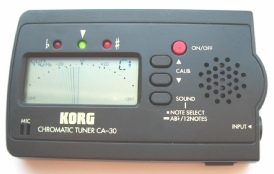
Alex Fender © Fender Piano Services 2013 - 2019

Welcome to
Tel: 0800 233 5440 - Mobile: 07725 120137
Free-phone number!
I’m often asked about tuning and how it’s done - I’ve been doing it so long it has become second nature but the science behind it is quite complicated and also very interesting.
Some tuners start from middle C, but I like to start from A above middle C. It’s entirely a matter of choice as long as the whole thing sounds right when complete! I always use a tuning fork (A=440) to set the pitch for the A. The ‘440’ is the cycles per second that the note produces. I’ll actually set the A one octave down (the one above middle C), which will vibrate at a rate of 220 cycles per second. Once I’m happy that the A is exactly in tune with the fork I can then set the rest of the ‘scale’. The scale is the most important part as every other note in the piano is tuned from it. It requires the greatest concentration to get it right!
I’m often asked about ‘Perfect Pitch’ - this is something that does not exist! Read about it here.
From the A, I tune the note E, up a fifth and the note D, up a forth from A, then from D down to G and from G up to C. This gives me a check of the third, C to E and the sixth, G to E. I can carry on in fourths and fifths till I end up at F. (The complete list is to the right) All the thirds should run slightly faster when starting at G/A up to C/E. There must be a slight beat (in effect, slightly ‘out’ of tune) in all the fourths and fifths in order to obtain equal temperament
A-E
A-D
D-G
E-B
B-F#
F#-C#
C#-G#
G#-D#
D#-A#
A#-F
Before we go any further it’s important to understand our modern tuning system. We use ‘equal temperament’, which basically means that every semitone is the same ‘distance’ apart. If you were to tune the scale so every fourth and fifth sounds exactly right (with no beats, beats are the ‘wow wow’ sound when it’s not quite in tune) you will find that the last semitone in the scale is further apart than the rest, in my scale that would be the E to F. So, to create equal temperament we need to spread this ‘gap’ throughout the scale. You could say that in order to be in tune, it needs to be out of tune!
Interestingly, our modern tuning is not thanks to Bach and his 48 preludes as some think but actually Pythagoras who worked out the scale mathematically. (As we are lead to believe - whether or not it really was Pythagoras is open to debate!) We know that A is 440 cycles per second (cps) and the next A down is 220 cps then 110 cps so it’s a mathematical calculation to work out the notes in between. If we take the frequency of A as 440 and multiply by the 12th root of 2 (1.0594631) we will get the frequency for A#, take that frequency and multiply by 1.0594631 we get B and so on. Eventually we’ll get to 880, the next A up!
Simple!…not! To get the intervals to run evenly takes years of practice!
One thing is certain - there is no such thing as the perfect tuning. Equal Temperament relies on a compromise between notes. No two pianos can ever be exactly the same and no two tuners will tune the same scale. There will always be subtle differences. In theory, yes you can get a perfect tuning but in practice it’s not possible due to imperfections in the piano and the human ear. The strings on the piano have imperfections as does the bridge, hammers, string length and so on. Even the most expensive pianos in the world will have some notes that sound very slightly different, that’s the nature of the piano.
At the end of the day I always say, “If it sounds right, it is right!”

I’m sometimes asked about these electronic tuners you can buy. They are great for guitars and the like but they can’t pick up the tiny variations on the piano like the human ear can. I tried one out some time ago and yes, it was close but it didn’t sound right. It couldn't ‘hear’ the notes at all at the very top and bottom of the piano.

Another common thing I hear said is that digital pianos are perfectly tuned and always stay in tune. Yes, the modern ones will stay in tune but whether are they ‘perfect’ is certainly open to scrutiny! I find that on many the C-F interval runs too fast for my liking. This is where the compromise changes! For me, the digital piano lacks colour and character.
I think there is wisdom in saying “Real pianists play real pianos!”